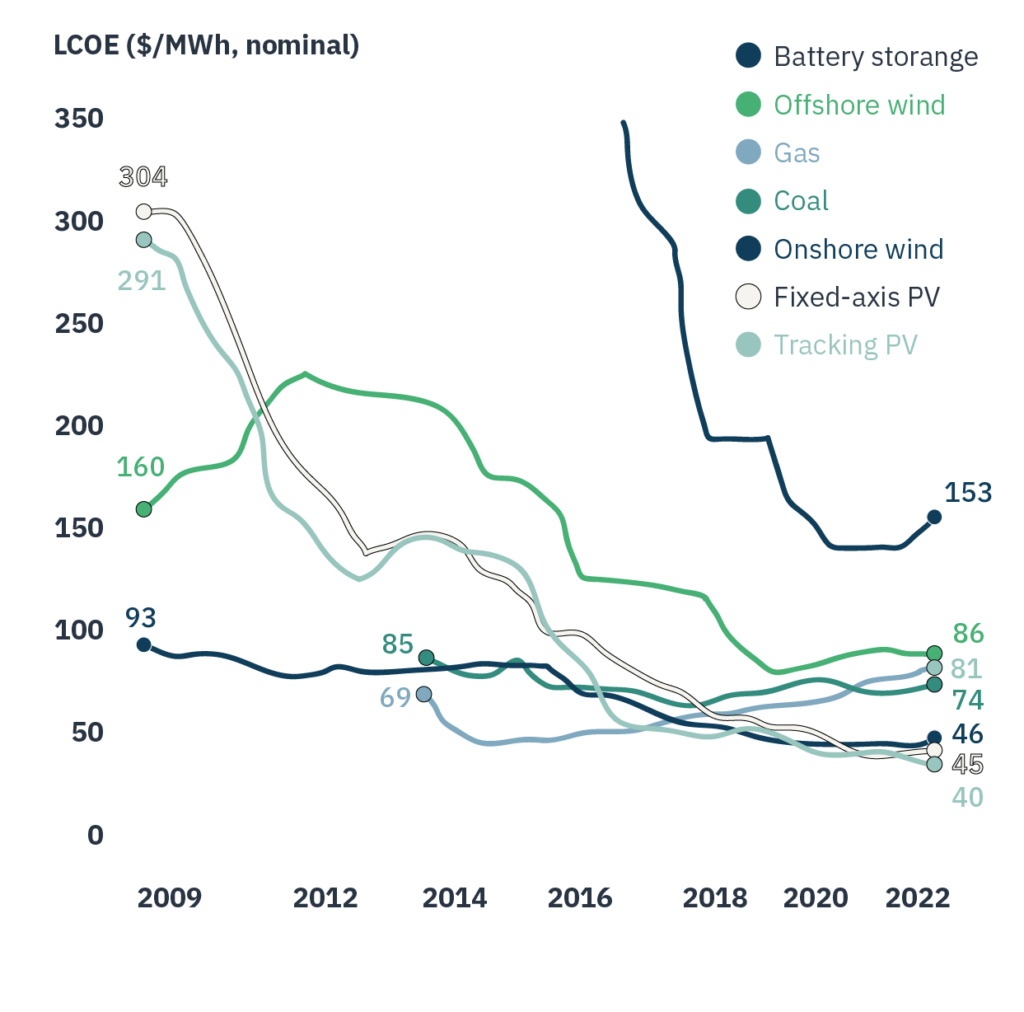Many view renewable energy as a new frontier – the latest phase of innovation in a highly technical field that is relatively recent in human history. However, humans have been harnessing renewable energy for centuries, long before electricity was discovered and capitalised for human use.
From sailing ships to milling wheat
From as early as 2000 BCE, naturally occurring forces such as wind and water flow have been vital to human development and success; from sailing ships opening trade and communications across the ancient world, to water- and windmills being used to process food and irrigate agricultural land in Europe from the 2nd century BCE.

Source: © Lidia Fourdraine/Wiki Commons
Jumping forward to the industrial age, since the invention of the turbine generator in the 1860s, humans have been able to convert almost any force strong enough to turn a turbine into usable electricity. This concept is most obviously applied to wind and hydro.
Harnessing the power of wind
The first modern wind turbines developed to generate electricity were developed in the 1880s. Private use, especially in remote agricultural settings, expanded through the late 19th and early 20th centuries and the first commercial onshore wind farms were developed in the 1980s and 90s.

The UKs first wind farm was constructed at Delabole in Cornwall in 1991. Consisting of 10 turbines with the capacity to produce enough energy for 2,700 homes – a site which is now owned by an investment company advised by Bluefield.
Wind is now the second biggest source of renewable energy globally with an estimated capacity of 837 GW – helping the world to avoid over 1.2 billion tonnes of CO2 annually, equivalent to the annual carbon emissions of South Americai.
Harvesting the sun’s energy
At the same time as advancements were being made in wind power, from the mid-19th century significant developments in the technology that would eventually enable solar generated electricity as we know it today. A French scientist in the late 19th century was the first to develop a solar ‘cell’ that utilised a phenomenon observed decades earlier – the photovoltaic (PV) effect. The photovoltaic effect is when voltage and electrical current are generated through a material when it is exposed to light. This technology was further developed by Bell Labs through the mid-20th century and remains the cornerstone of modern solar panels.
In recent years, further evolutions have made solar plants more efficient. New technology, such as BiFacial solar panels, generate power from both sides and can produce more electricity than conventional solar panels.
Today, there is approximately 500 GW of installed solar capacity worldwide, with estimated projections of an additional 316 GW to be built across the world in 2023.
The next frontier – smoothing power supplies using battery storage
One of the greatest challenges for renewable energy is its reliance on the sun shining and wind blowing at the same time as when energy is needed. Battery storage systems are increasingly being installed alongside solar and wind farms to store power for use overnight or when the elements are not participating.
Storage battery technology has been available since the 1800s, when German physicist Carl Gassner developed the first rechargeable cells, based on an earlier discovery by Italian Luigi Galvani that muscles contract when touched with two different metals. However, it was not until the end of the century that a Swedish engineer invented the first modern storage batters, a nickel-cadmium battery. A year later Thomas Edison, the inventor of the lightbulb, invented a nickel-ion storage battery. By the mid-20th century commercial batteries of different compositions were in common use in many households.
So far batteries have been predominantly based on lithium-ion batteries, essentially the same technology as modern rechargeable batteries for daily use. Other battery technologies, such as redox flow batteries, solid-state batteries and lithium-air batteries are emerging and will likely play a role in future energy infrastructure.
The last couple of years have seen a proliferation of alternative battery technologies designed specifically to store energy produced by renewable means, including a sand battery in Finland and CO2 batteries in Italy.
Renewable energy becomes financially viable
In the first decades of the 21st Century, the cost of energy produced by renewable sources has decreased steadily, bringing both solar (PV) and onshore wind to well below the costs of gas and oil. 66% of the world’s population now live in a place where the cheapest form of energy is either solar or wind. This means renewable energy is set to play a key role in powering a carbon neutral futureii.
Global levelized cost of electricity benchmarks

The various technologies required for and associated with renewable energy have continued to evolve with increased momentum and urgency in the 21st-centruy. Governments and private investors around the world are waking up to the looming climate crisis and recognising the pivotal role that renewable energy can play in alleviating global reliance on fossil fuels.
Get in touch to learn more about how Bluefield companies advise on investing in, managing, operating and developing modern solar, wind and battery facilities.
Bluefield, powering a sustainable future.
[i] Global Wind Energy Council, 2022
[ii] Bloomberg New Energy Finance, New Energy Outlook 2021
DISCLAIMER
This Article is being issued by Bluefield Partners LLP (Bluefield), which is authorised and regulated in the United Kingdom by the Financial Conduct Authority, to provide certain information about Bluefield Partners and its affiliated companies (the Bluefield Group). Bluefield’s registered office address is 40 Queen Anne Street, London, W1G 9EL and its FCA Firm Reference Number is 507508.
This Article is provided for educational and informational purposes only and does not constitute an offer to sell, or the solicitation of an offer to buy, any securities or financial products in any jurisdiction. This Article and the information contained therein is not intended for distribution or publication to persons outside the United Kingdom. This Article is not directed at, or intended for distribution to or use by, any person or entity that is a citizen or resident or located in any jurisdiction where such distribution, publication, availability or use would be contrary to applicable law or regulation or would require any registration or licensing within such jurisdiction. This Article is not a marketing communication. Recipients in jurisdictions outside the United Kingdom should inform themselves about and observe any applicable legal or regulatory requirements in relation to the distribution or possession of this Article in that jurisdiction.
The information contained in this Article is not intended to be, and should not be construed as, investment, financial, legal, tax or other advice, and is not a recommendation, endorsement or representation as to the suitability of any investment or financial product. You should seek independent professional advice before making any investment or financial product decision.
Past performance is not indicative of future results; no representation is being made that any investment will or is likely to achieve profits or losses similar to those achieved in the past, or that significant losses will be avoided. Any investment carries risk and the value of an investment can down as well as up. Capital at Risk.
The information contained in this Article is based on publicly available information and internally developed data, but no representation or warranty, express or implied, is made as to the accuracy, completeness or reliability of such information. Any projections or other forward-looking statements contained in this Article are based on assumptions that may change and actual results may differ materially from those expressed or implied in such projections or statements. This Article and any information contained within it may be amended or withdrawn at any time without notice. Bluefield and the Bluefield Group are not responsible for any losses sustained by any party in connection with the use of this Article and the information contained therein and disclaim all liability to the extent permitted by relevant applicable law and regulation.


